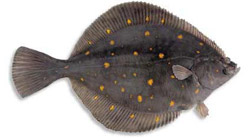Flatfish slime could become medication

Plie
Chemical engineer Trude Tvete has found a bacteria-killing protein in plaice slime, isolated the protein from the slime and tested it on staphylococcus bacteria.
“The protein from fish slime has proven itself to be extremely deadly for the bacteria I have tested”, says Trude Tvete, Nord-Trondelag University College (HiNT) in Norway.
Cleaned and tested slime
She has developed a technique to clean and separate the slime from plaice into its component parts and test it on several bacteria types.
“Previous research has shown that plaice slime kills bacteria, but it didn’t show which substance breaks the bacteria. I found that there is a protein in the slime that has the greatest effect,” says Trude Tvete.
Bacteria-killing substances from plants and animals are of interest for uses such as in hospitals that are beset with bacteria that has become resistant to antibiotics.
To make sure she had access to fresh plaice, she allied herself with local fishermen. In the laboratory, she scrapped the slime from the fish and testing with bacterial showed the slime with the greatest effect came from quite deep within the fish skin.
“So began the laborious work in the biotech laboratory to isolate the different substances from the fish slime. The protein we isolated was 95 percent pure in the end, and after that we tested it on the Staphylococcus aureus bacteria. It was shown to be very efficient at killing the bacteria”, says Trude Tvete.
Could become medication
The bacteria-killing proteins and the other substances are an important part of the plaice’s immune system. One result of this research is that this slime can become the source for new medications for humans.
Because new infections constantly appear around the world as some bacteria become resistant to antibiotics, it is important to find new bacteria-killing agents. Substances from fish are especially interesting. The plaice has the potential to be fish farmed, and bio-products such as antibiotic agents could possibly increase the value of such an enterprise.
“Many bacteria-killing substances from mammals have been researched, but few have studied fish. The substances that can be isolated from fish have several properties that make them an attractive starting point for production of medications. They are built-up in a different way and can therefore overcome bacteria that have become resistant to antibiotics”, explains Trude Tvete.
In the chemical engineering area at HiNT’s engineering department, research on the bacteria-killing properties of fish slime has been underway for several year. Several undergraduate chemical engineering students have worked with plaice slime as part of their major project.
Media Contact
More Information:
http://www.forskningsradet.no/All latest news from the category: Life Sciences and Chemistry
Articles and reports from the Life Sciences and chemistry area deal with applied and basic research into modern biology, chemistry and human medicine.
Valuable information can be found on a range of life sciences fields including bacteriology, biochemistry, bionics, bioinformatics, biophysics, biotechnology, genetics, geobotany, human biology, marine biology, microbiology, molecular biology, cellular biology, zoology, bioinorganic chemistry, microchemistry and environmental chemistry.
Newest articles

Properties of new materials for microchips
… can now be measured well. Reseachers of Delft University of Technology demonstrated measuring performance properties of ultrathin silicon membranes. Making ever smaller and more powerful chips requires new ultrathin…

Floating solar’s potential
… to support sustainable development by addressing climate, water, and energy goals holistically. A new study published this week in Nature Energy raises the potential for floating solar photovoltaics (FPV)…

Skyrmions move at record speeds
… a step towards the computing of the future. An international research team led by scientists from the CNRS1 has discovered that the magnetic nanobubbles2 known as skyrmions can be…





















